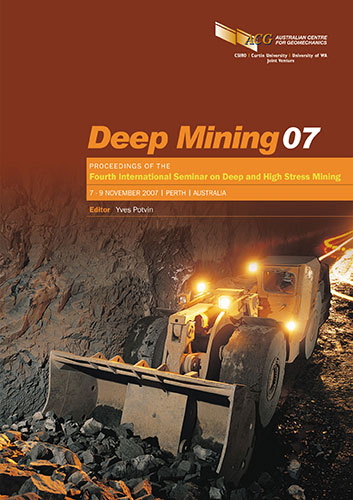Optimising the Use of Cemented Backfill by Using an Effective Stress Constitutive Model

|
Authors: Fourie, A; Helinski, M; Fahey, M |
DOI https://doi.org/10.36487/ACG_repo/711_31
Cite As:
Fourie, A, Helinski, M & Fahey, M 2007, 'Optimising the Use of Cemented Backfill by Using an Effective Stress Constitutive Model', in Y Potvin (ed.), Deep Mining 2007: Proceedings of the Fourth International Seminar on Deep and High Stress Mining, Australian Centre for Geomechanics, Perth, pp. 425-435, https://doi.org/10.36487/ACG_repo/711_31
Abstract:
Cemented backfill is an important contribution to ground support, particularly in high stress conditions. The rate at which strength, and more importantly stiffness, increases with time after placement of backfill is crucial to the safe and reliable use of this technology, but is an area that is currently poorly understood. The importance of the interaction between fill type, binder and water used during the hydration process and their impact on the rate of gain of stiffness and strength is highlighted. The principle of effective stress is critical to understanding how pore pressures generated during placement and consolidation of backfill affects the loads on barricades used to retain the newly-placed fill. Based on laboratory and in-situ experimental work, a constitutive model has recently been developed at the University of Western Australia that considers strength and stiffness gain with hydration time, self-desiccation and the effect on pore pressures in the fill. A comparison of pore pressures developed during the staged filling of a stope is used to illustrate the versatility of the model when incorporated into a finite element package. The utilisation of this model enables the choice of fill and binder combination to be optimised, and provides greater certainty in the use of cemented backfill in high stress conditions.
References:
Been, K., Brown, E.T. and Hepworth, N. (2002) Liquefaction potential of paste fill at Neves Corvo mine, Portugal.
Mining Technology: IMM Transactions section A, 111(1), pp. 47-58.
Belem, T., Harvey, A., Simon, R. and Aubertin, M. (2004) Measurement and prediction of internal stresses in an
underground opening during filling with cemented fill. Proceedings 5th International Symposium on Ground
Support, Villaescusa and Potvin (eds), Balkema Publishers, 28-30 September, Western Australia, pp. 619-630.
Biot, M.A. (1941) General theory of three dimensional consolidation. Journal of Applied Physics, 12, pp. 154-164.
Coltrona, A. (2006) Material properties of cemented minefill. Final year thesis, School of Civil & Resource
Engineering, University of Western Australia, Perth, Australia.
Fahey, M. and Carter, J.P. (1993) A finite element study of the pressuremeter test in sand using a non-linear elastic
plastic model. Canadian Geotechnical Journal, 30, pp. 348–362.
Fourie, A.B., Fahey, M. and Helinski, M. (2007) Using effective stress theory to characterise the behaviour of backfill.
CIM Bulletin, August 2007, Vol. 100, 9 p.
Grabinsky, M.W. and Bawden, W.F. (2007) In situ measurements for geomechanical design of cemented paste backfill
systems. CIM Bulletin, August 2007, Vol. 100, 10 p.
Grice, A. (1998) Stability of hydraulic backfill barricades. Proceedings Minefill ’98 – Sixth International Symposium
on Mining with Backfill, Brisbane, Australia, April 1998, AusIMM, pp. 117-120.
Grice, A. (2005) Introduction to hydraulic fill. Handbook on Mine Fill, Potvin, Thomas and Fourie (eds), Chapter 5,
Australian Centre for Geomechanics, Perth 2005.
Hassani, F.P., Ouellet, J. and Hossein, M. (2001) Strength development in underground high-sulphate paste backfill
operation. CIM Bulletin, 94, pp. 57-62.
Helinski, M., Fourie, A.B. and Fahey, M. (2006) Mechanics of early age cemented paste backfill. Proceedings 9th
International Seminar on Paste and Thickened Tailings (Paste 2006), Jewell, Lawson & Newman (eds),
Limerick, Ireland, April, Australian Centre for Geomechanics, pp. 313–322.
Helinski, M., Fourie, A.B. and Fahey, M. (2007a) The self desiccation process in cemented mine backfill. Accepted for
publication, Canadian Geotechnical Journal.
Helinski, M., Fahey, M. and Fourie, A.B. (2007b) An effective stress approach to modelling mine backfilling. CIM
Bulletin, August 2007, Vol. 100, 10 p.
Optimising the Use of Cemented Backfill by Using an Effective Stress Constitutive Model A. Fourie, et al.
434 Deep Mining 07, Perth, Australia
Marston, A. (1930) The theory of external loads on closed conduits in the light of latest experiments. Bulletin No. 96,
Iowa Engineering Experiment Station, Ames, Iowa.
Potvin, Y. and Fourie, A.B. (2005) Paste fill in Australia. Symposium 2005 on Mines + Environment, Rouyn, QC, May
2005, pp. 16-18.
Rankine, R.M., Rankine, K.J., Sivakugan, N., Karunasena, W. and Bloss, M. (2001) A numerical analysis of the arching
mechanism in pastefill throughout a complete mining sequence. Proceedings 1st Asian Pacific Congress on
Computational Mechanics, Sydney, pp. 461-466.
Terzaghi, K. (1943) Theoretical soil mechanics. John Wiley and Sons, New York.
Yumlu, M. and Guresci, M. (2007) Paste backfill bulkhead failures and pressure monitoring at Cayeli Mine. CIM
Bulletin, August 2007, Vol. 100, 10 p.
Various Topics
Deep Mining 07, Perth, Australia 435
© Copyright 2025, Australian Centre for Geomechanics (ACG), The University of Western Australia. All rights reserved.
View copyright/legal information
Please direct any queries or error reports to repository-acg@uwa.edu.au
View copyright/legal information
Please direct any queries or error reports to repository-acg@uwa.edu.au